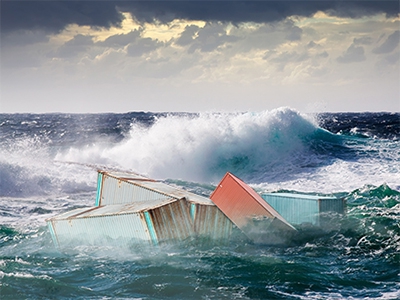WSC issues survey results for containers lost at sea
The World Shipping Council (WSC) issued its updated survey results on containers lost at sea for six year period from 2008 to 2013. The survey results showed that there were 546 containers lost on average each year.
In 2013, the international liner shipping industry carried approximately 120 million containers packed with cargo, with an estimated value of more than $4 trillion. Proper packing, stowage and securing of containers is very important to the safety of a container ship, its cargo and its crew, to shore-based workers and equipment, and to the environment. Even with proper packing of the cargo into the container, proper container weight declaration, and proper stowage and securing aboard ship, a number of factors ranging from severe weather and rough seas to more catastrophic and rare events like ship groundings, structural failures, or collisions can result in containers being lost at sea.
Obtaining an accurate assessment of how many containers actually are lost at sea has been a challenge. There have been widely circulated, but unsupported and grossly inaccurate statements that the industry might lose up to 10,000 containers a year at sea. A number of submissions to the International Maritime Organization (IMO) have included similar numbers without any substantiation.
In an effort to gain greater clarity on the issue, in 2011 and again in 2014, the World Shipping Council (WSC) undertook a survey of its member companies to obtain a more accurate estimate of the number of containers lost at sea on an annual basis.
Combining the results of the two WSC surveys over the six year period from 2008 to 2013, the WSC estimates that there were on average 546 containers lost at sea each year, not counting catastrophic events, and on average a total of 1,679 containers lost at sea each year including catastrophic events.
The data demonstrates that container losses in any particular year can vary quite substantially based on differences in weather and based on the extent to which there may be one or more catastrophic vessel losses. For example, in 2011 (the year of the loss of the M/V Rena) there was a total annual loss of 1,514 containers. In 2012, there was a total loss of 958 containers. In 2013, there was a total loss of 5,578 containers 77% of which occurred with the sinking of the MOL Comfort in the Indian Ocean.
| Active Safety Improvement Initiatives |
|
While containers lost overboard represent a very small fraction of the roughly 120 million container loads shipped each year, the industry has been actively supporting a number of efforts to enhance container safety that should help reduce the number of containers lost at sea, including: Amendments to the Safety of Life at Sea (SOLAS) Convention: The IMO has before it amendments to the SOLAS Convention that will require container weight verification as a condition for vessel loading and will consider these amendments for adoption in November 2014. Misdeclared container weights have contributed to the loss of containers at sea, as well as to other safety and operational problems. New Code of Practice for Packing of Cargo Transport Units (CTU): The IMO, the International Labour Organization (ILO), and the United Nations Economic Commission for Europe (UNECE), with industry support, have produced a new code of practice for the packing of CTU, including containers, outlining specific procedures and techniques to improve safety, such as how to ensure equal distribution of weight inside the container, proper positioning, blocking and bracing according to the type of cargo, and other safety considerations. The new code has been approved by the IMO and the UNECE and is expected to receive final approval by the ILO in November 2014. Revised ISO standards for container lashing equipment and corner castings: As part of its efforts to enhance container safety, the IMO has requested the International Organization for Standardization (ISO) review and revise its standards regarding lashing equipment and corner castings. The ISO is working on these issues with the industry’s active participation. |
Any loss of a container at sea is a loss that carriers seek to prevent. While the actual number of containers lost at sea is significantly less than many public statements cite, the industrys goal continues to be to reduce those losses to as close to zero as possible.
Source: World Shipping Council






























































